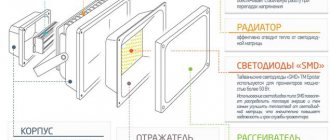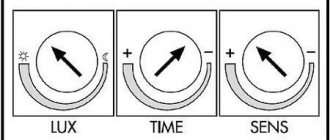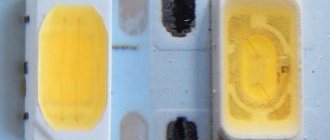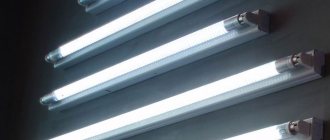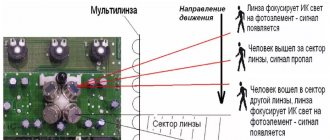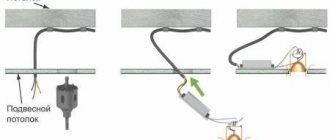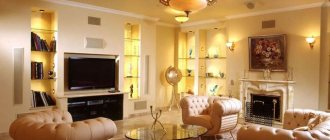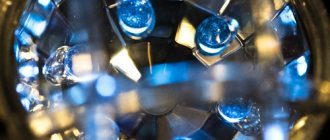In many countries, energy-saving technologies have been introduced over the past decades. Since 2012, a number of European countries have completely eliminated the use of sodium lamps, switching to LED lighting devices for street lighting. You can read about the use of LED lighting in this article. In our country, this type of lamps is actively replacing not only sodium lamps, but also halogen ones, because with experience it has become clear that devices with LEDs are more economical and cheaper to use, despite the initially high price.
Today, not everyone has a complete understanding of how to choose street lamps, what characteristics they differ in, what is important to know before installation and how to achieve sufficient lighting.
Let's talk about the advantages and important technical indicators of LED lamps and answer the common question, what should street lighting be like?
Recommendations for choosing lamps
The following points will help when choosing artificial lighting, and you can learn about the types and types of lighting here:
- determine the main tasks that the artificial lighting source must solve;
- describe the design characteristics: fastening method, lamp power, material;
- find out the required level of protection from the external environment: level of protection from moisture, precipitation, dust. To do this, it is necessary to highlight the features of the environment in which the artificial light source will be used;
- choose the style of the product;
- study manufacturers, compare the advantages of available options;
- indicate the desired price.
Selection of lighting fixtures taking into account the type and purpose of lighting
Before purchasing an artificial lighting device, it is necessary to determine the purpose assigned to the device and its purpose.
Depending on the function, the lights can be:
- technical - have a discreet design, selected taking into account the brightness and completeness of lighting;
- decorative - installed to create lighting effects and as part of the interior of the space;
- universal - they combine two tasks: increasing visibility at night and decorative decoration of space.
Depending on the place of application, the lamp can be of the following subtypes:
- for street lighting (installed to illuminate important objects, meet high technical requirements);
Lamps for street lighting - for landscape lighting (solves a decorative problem);
- architectural (building lighting).
Lamps for illumination of buildings
Street lighting devices are divided into the following types:
- lanterns;
- decorative light source;
- spotlight.
What else to pay attention to before buying
When choosing budget street lighting, you need to consider:
- lamp service life . There is a mark on the packaging where the service life is indicated in the range from 50 to 100,000 hours. However, the final value depends on the temperature inside the device case. It is important to pay attention to heat dissipation, since high temperatures cause problems in operation and reduce the life of the lamp;
- Colorful temperature . The indicator falls in the range from 3,000 to 6,000 K. The choice may be based on the personal preferences of the buyer;
- color rendering This characteristic is not critical for street lighting. When installing lighting devices at important objects, it is better to choose a device with a color rendering index of at least 90. Modern devices have an index of at least 80;
- dimming _ The ability to change the brightness of the lighting is another important factor when choosing devices. To make adjustments, the built-in lamp driver must have a function that allows dimmer commands to be executed;
- Operating temperature range . Manufacturers often provide incorrect information on the device packaging. The minimum temperature cannot be lower than –40 degrees Celsius. On the label you can find a parameter of up to -60 degrees Celsius, which is not true. When choosing devices, keep an eye on this parameter;
- built-in sensors . Additional device functions: light, noise or motion sensor. These built-in capabilities allow you to expand functionality and increase energy savings. For example, increasing the light level when required.
Color quality
Among the advantages of LEDs compared to some other light sources is better color rendering. First of all, we are talking about the significant superiority of LEDs over NLVDs in this parameter, despite the fact that both sources have comparable light output. Indeed, if the CRI for NLHD is 20...30, then for modern white LEDs from leading manufacturers it rarely falls below 60. From this we can conclude that the use of LEDs instead of NLHD may be advisable for architectural lighting, as it improves the quality of the spectrum. The exception is those cases when the illumination of a yellow hue, characteristic of NLVD, was initially determined by the architect’s plan.
If we rely only on such an indicator as CRI, then the LEDs here are approximately at the level of LL and CFL and are inferior to the best MGL samples. A series of LEDs intended for outdoor lighting, as a rule, have a CRI of no more than 80, which is due to the need to provide greater light output and, therefore, greater luminous flux. In relation to LEDs, a simple rule applies - all other things being equal, the higher the light output, the lower the CRI value.
RLDs should be considered separately - they are inferior in color rendering to LEDs, but this is not due to the principle of operation, but to purely economic reasons. RLVD technology is outdated, significant funds have not been invested in its development, moreover, street lamps based on RLVD are often positioned in the lower price segment and high requirements are not placed on the quality of color rendering of lamps.
But the CRI value only reflects the accuracy of eight colors (in the extended version - 14) and does not reflect such an indicator as spectrum continuity. For gas-discharge sources, the spectrum consists of individual lines. With LEDs it is continuous, which is a big advantage. Those. with the same CRI as a gas-discharge light source, LEDs will subjectively have better color rendition. However, so far, methods for assessing color rendering taking into account spectral continuity have not been standardized. Therefore, when designing outdoor lighting, the justification for using LEDs instead of MGLs to improve the quality of the spectrum can only be based on subjective opinion. However, there is one point that makes it advisable to use LEDs instead of MGLs. We are talking about the effect of changing color temperature over time, characteristic of MGL. Anyone can observe it, just walking around the evening city. The illumination of buildings made using MGL acquires an unpleasant greenish tint over time. It spoils the impression even more when the change in color temperature is different for lamps illuminating the same building.
LED lamp protection class
The lamp body is quite strong, stable and able to withstand a certain load coming from the environment. But the level of protection of devices can vary greatly - when choosing a device, you should remember this parameter and focus on the intended operating conditions of the lamp.
Luminaires differ in class, which is assigned based on the IEC-952 standard for protection against external factors.
The first digit of the indicator indicates the level of resistance of electrical equipment to solid particles, the second value indicates resistance to moisture. The exact data can be studied in the table with a complete description of the degrees of IP protection that can be found on the World Wide Web. Based on the calculation of street lighting illumination and the indicators given in the table, you can make decisions about installing one or another type of lamp in the given conditions. To illuminate an area near the water, it is better to choose a lamp with protection class IP66, and for lighting a summer cottage, a lamp of IP64 class is suitable.
conclusions
Currently, it is difficult to draw an unambiguous conclusion about the absolute advantage of one type of lamp over another. In each specific case, careful economic calculations are required.
LEDs have already reached such a level of development (XM-L, XT-E) that it is possible to produce a lamp that is even more efficient than a product made with a sodium lamp. Of course, the initial cost of an LED lamp is quite high, but the operating costs are much lower, and in the end it may be economically feasible to use an LED lamp instead of a lamp with a sodium lamp. Taking into account that the development of LED technologies is proceeding at a fairly rapid pace, there is a constant decrease in cost and the efficiency limit has not yet been reached, we can confidently predict the inevitable and obvious superiority of LEDs over traditional, even the most efficient, light sources in the near future.
Obtaining technical information, ordering samples, delivery - e-mail
•••
Power and luminous flux
Different areas of the territory require different levels of illumination. When developing a lighting plan for important public areas (roads, driveways, stadiums), calculations are made of the required luminous flux, the number of lighting devices and their efficiency, based on street lighting rules.
The illumination of a space is measured in lux (lux) by a specialized device - a luxmeter.
Luxmeters
SNiP 05/23/2010 indicates calculations of the appropriate level of illumination for various objects. Street lighting must comply with strictly specified standards. The device is installed with an additional reserve, since after time the luminous flux decreases.
The illuminance index is related to the amount of luminous flux, measured in lumens (lm). This is the amount of light power that the light source in question can provide. The level of illumination directly depends on the luminous flux indicator. These quantities are directly proportional.
Answering the question: how to calculate street lighting, mention should be made of calculating the required amount of luminous flux. To calculate, you will need to have the following indicators:
- required level of illumination;
- the area of the land;
- distance from the light source to the surface;
- radiation angle.
Specialized calculators are used for calculations.
In the instructions and description of the lamp, both the luminous flux (lm) and luminous efficiency (the ratio of light to 1 W of power) are indicated. LED lamps are characterized by economical energy consumption. To provide a luminous flux of 7500 lm, a sodium lamp must have a power of at least 180 W, while an LED lamp must have a power of at least 80 W.
Luminous efficiency (lm/W) is inversely proportional: the higher the value, the more economical the device. The maximum value reaches 100 lm/W.
Energy efficiency
When people talk about LEDs, the first thing they mention among their advantages is high light output. If we look at Table 1, LEDs currently compete only with NLVDs. However, everything is not so simple here.
Table 1. Comparison of typical characteristics of traditional light sources and LEDs
| Light source type | Light output, lm/W | Service life, h | Color rendering index CRI | Dimmable |
| LL | 50…100 | 8000…20000 | 70…85 | to 10% |
| CFL | 50…60 | 8000…10000 | 70…85 | only certain lamp models, up to 15% |
| GLN | 15…20 | 2000 | 100 | up to 0% |
| MGL | 70…85 | 10000…12000 | 75…99 | only certain lamp models, up to 50% |
| RLVD | 50…60 | 8000…10000 | 60…80 | not applicable |
| NLVD | 80…150 | 10000…25000 | 20…30 | only certain lamp models, up to 50% |
| LEDs | 100…150 | 50000 | 65…90 | up to 0% |
Firstly, the NLVD gives light in all directions, while the LED only shines in one. If we are dealing with a street lamp that shines in one direction (on the road), then the NLVD will require an optical system with a reflector, for which losses of up to 35% of the luminous flux are inevitable. LEDs shine in one direction; you will need a lens to redistribute the light flux and a protective shade. In the best models of outdoor LED lamps, losses in the optical system are up to 25% (glass plus optics). A simple calculation shows that only due to this energy efficiency feature, an LED with a luminous efficiency of 150 lm/W, all other things being equal, will correspond to an NLVD with a luminous efficiency of 162 lm/W, if it were mass-produced.
Secondly, the current trend is to save money not only through increased light output, but also through more efficient control of light sources. For example, on a road where traffic flow is significantly reduced at night, you can reduce the lighting during this time and save electricity. But there are some problems with NLVD. Dimming is allowed only for certain lamp models. In practice, dimming is only possible up to 50%. In this case, the power consumption changes in a much smaller proportion, that is, there is practically no gain in energy consumption. If it is necessary to reduce energy consumption at night, lamps with low-pressure high-pressure power supply on the road are simply turned off every other time. This method of reducing illumination, although permitted by the rules, worsens the uniformity of illumination of the road surface. Therefore, from a safety point of view, it is better to use dimming rather than turning off some of the luminaires. Unlike NLVD, LEDs can be dimmed down to zero level. At the same time, which is very important, power consumption decreases in approximately the same proportion as the decrease in illumination level.
What not to do with street lamps
When working with the installation and operation of street light sources, you should remember safety measures. The following list will help you work safely:
- installation of devices should be carried out after turning off the power supply;
- When working with lighting devices, hands must be completely dry from moisture;
- No moisture or drops of water should enter the device housing. Due to violation of safety precautions during installation, a short circuit may occur;
- all electrical connections must first be insulated from moisture;
- When working, it is important to pay attention to the serviceability of the electrical wiring. If it is damaged, it is prohibited to connect devices;
- The light source must not be installed with the glass facing up;
- street lamps and spotlights are prohibited from being installed or connected in the immediate vicinity of chemicals and various flammable substances;
- if the cable insulation or the device casing is damaged, its installation and operation for its intended purpose is impossible;
- The light source should be turned off if the light begins to flicker or the brightness decreases suddenly.
It is important to remember that any mechanical damage to the device body can trigger an electric shock.
Products by topic
- Choose …
View
White polycarbonate diffuser tubes
1508 ₽ – 1695 ₽
- Choose …
View
Tube diffusers made of opal polycarbonate
745 ₽ – 1858 ₽
- Choose …
View
Transparent polycarbonate diffuser pipes
628 ₽ – 1616 ₽
- Choose …
View
Transparent polycarbonate pipes
339 ₽ – 65525 ₽
- Choose …
View
Opal polycarbonate pipes
376 ₽ – 50371 ₽
- Choose …
View
White polycarbonate pipes
358 ₽ – 47973 ₽
- NEW!
Choose …
View
Rectangular polycarbonate diffuser profile
185 ₽
- NEW!
Add to cart
View
Square polycarbonate diffuser profile
205 ₽
What parameters should be taken into account when choosing street lamps
Street lighting systems include the following parameters:
- purpose – its characteristics will depend on the purpose and location of installation of the device;
- technical properties;
- aesthetic parameters;
- efficiency - the most economical solution is LED devices and solar-powered devices;
- lighting area;
- type of construction and fastening;
- lifetime.
Street lighting fixtures must be placed in accordance with legal regulations.
What kind of light bulbs are used in street lamps?
The following types of lamps are used in street lighting devices:
- gas-discharge - mercury, xenon, sodium, neon;
From left to right: mercury, xenon, sodium, neon
- luminescent - economical, have a long service life, cannot withstand low temperatures;
Fluorescent lamps
- LED - have a long service life (up to 25 years), are economical, do not flicker.
LED lamp and luminaire
Outdoor lighting temperature
Varieties of color temperature:
- 2700-3000 K – warm light;
- 3500-4100 K – daylight;
- 5000-6500 K – cold light.
To illuminate public areas, devices with a color temperature from 2700 to 4100 K are installed.
Lamps with cold light are installed in stadiums, gas stations and for architectural lighting.
Types of street lamp design
When buying a lighting device, pay attention to the design features of the lighting device:
- street lamp and floor lamp - has a support mast with a lampshade installed on it;
- wall mounting - spotlights for architectural lighting, can be elements of decorative finishing of the facade;
- pendant lamps - used to illuminate the landscape;
- ground devices - installed for landscape lighting or territory decoration, built into the ground;
- built-in light sources - used to illuminate individual elements, installed for decorative purposes.
Choosing an LED Floodlight
An LED street floodlight must meet the specified parameters, as well as comply with accepted norms and standards (including GOST). Floodlights are used to illuminate industrial facilities, residential areas, multifunctional complexes and other buildings. Therefore, the range of devices is very diverse: you can always choose what suits you.
According to their purpose, lamps are divided into several groups:
- Lighting - they are used as the main source of light on the street.
- Architectural - designed to illuminate the facades of buildings, memorials and monuments.
- Decorative - used to decorate areas and create a festive atmosphere.
Smart lighting
To automate the processes of turning on/off lighting in order to save energy, the following are used:
- photo relay - turns on the light source at dusk and turns off at dawn;
- astronomical relay - switches the device based not on the light level, but on the geographic coordinates of the area, which are entered manually;
- motion sensor – turns on the lighting when motion is detected in a given range;
- temporary relay – provides for manual activation of the system and automatic shutdown after a specified time period.
Measuring devices
To calculate the illumination in a specific area, special devices are used - lux meters. One of the most popular devices is the “Yu-116”, which can record illumination in natural light or in an incandescent lamp. It is an indispensable equipment used in agriculture, transportation industry, etc.
Ripple and other characteristics are measured by analog-to-digital devices. One of the striking examples is the ARGUS-07 pulse meter-lux meter. It converts the luminous flux emitted by oblong objects into electrical impulses that will be proportional to the illumination. After this, decoding into a digital code occurs, which allows you to see the final result on the device display.
Useful tips
Choosing devices for street lighting:
- incandescent lamps have a short service life and consume large amounts of electricity;
- devices with gas-discharge lamps illuminate the landscape in the best way;
- for parks it is better to use halogen lamps;
- LED lights have low energy consumption and produce a strong luminous flux.
When choosing a device, it is necessary to formulate operational requirements for lighting and study the technical data. When purchasing lamps, you should ask for the manufacturer’s accompanying documentation, paying special attention to the technical indicators of the LEDs.
When choosing and purchasing lamps, have a lux meter and a multimeter with you - this will allow you to check the declared characteristics on the spot and buy a lamp that meets the parameters.
Classification of LED spotlights
In each specific case, the required number of lighting fixtures and the location of the spotlights are selected. It happens that it is necessary to install several floodlights on different sides of the building. Therefore, experts recommend drawing up a plan in advance for developing outdoor lighting.
There are different classifications of LED devices:
- According to the light spectrum - from 3700 to 6000 K.
- In terms of power - from 10 to 500 W.
- In terms of brightness - 700-3400 Lumens.
- According to the degree of protection from moisture and dust (models with a protection level of IP54 and higher are suitable for street lighting).
Basic criteria for choosing lighting devices
Types of light sources for illuminating city streets must be selected strictly based on certain criteria:
- traffic intensity;
- climatic features;
- degree of protection;
- it is important to take into account all the negative influences of the surrounding world;
- required light saturation;
- installation and installation features.
The choice of a particular device should be based on the goals set by the service involved in lighting and design of city streets.
Advantages and disadvantages
Outdoor lighting has a number of positive aspects:
- Increased energy efficiency of light bulbs. Such lamps consume 7 times less energy, LN;
- Long service life. If the lamps work only at night, then the service life of street lamps can exceed 15 years;
- Street lighting can withstand temperatures from -50 to +50 degrees. Also does not depend on sudden changes in weather conditions;
- Street lamps are resistant to damage; they can fall, but not break and continue to function.
The main disadvantages of street lamps:
- The main disadvantage is the high price. But it completely pays for itself with the quality of the lamps;
Pole lights
- When using lamps with a power of 50W or more, you need to use a high-quality heat sink. If the factory skimps on the quality of the raw materials intended for this, the lamp will quickly burn out;
- Light bulbs react to power surges and can quickly fail. Therefore, it is important to purchase a good power supply and stabilizer.
Why do you need a calculation?
Despite the apparent simplicity of street lighting, lighting fixtures installed in the local area cannot be placed arbitrarily. You need to focus not only on symmetry and fashion, but also follow several general requirements and recommendations.
Before installing supports for lanterns, make an accurate calculation, thanks to which you will ensure high-quality and uniform lighting of the entire space using a minimum number of lamps. This will save time and money!
Conventionally, street lighting can be divided into:
- Facade - spotlights and lamps that are mounted on architectural structures and provide spot light;
- Landscape – can designate garden paths and courtyard boundaries, or highlight individual shrubs, ponds, sculptures, and so on;
- Diffused street lighting - mainly represented by lanterns installed in a certain order and at a high altitude; they provide diffused but bright light.
Classification by functionality:
- Technical – used to illuminate main paths, gates, areas near the front door, etc.;
- Flood – a diffused stream of light to illuminate a large space;
- Decorative – for spot illumination of objects on a personal plot;
- Accompanying - this category includes lamps that react to movement.


